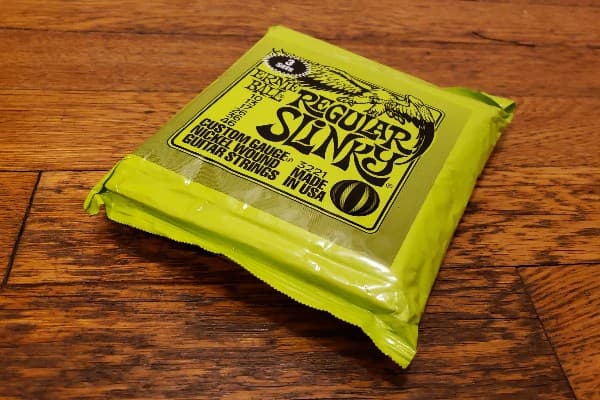So much of light audio recording talks guitars. Guitars are no use without strings. Ernie Ball’s Regular Slinky are the strings of choice for electric guitars. So, let’s take a closer look at them.
Background
There are many reasons players latch onto a certain type or brand of string. And mine… well… it comes down to marketing.
So, when I lived in the UK, and I was playing with a band, I had a part-endorsement deal with a company, where I paid UK£2 for a set of strings. Now, they did the job, but they weren’t the nicest – I knew this… they were £2 strings.
One day, I needed strings in an emergency. So, I went to PMT in Brum with the intention of just getting one set of strings, because I knew they’d cost a lot more than £2.
However, on arrival, there was a promotion on Ernie Ball strings, where three sets were only £10, as opposed to £6 for the single set that I needed.
Ultimately, I bought six sets of electric guitar strings, and three sets of acoustic guitar strings.
And that was enough for the sales staff in the store to throw in an Ernie Ball mug. Which you may recognize from my coffee.
Ernie Ball Regular Slinky electric guitar strings specs
| Guitar type | Electric |
| Number of strings | Six |
| Coated? | Nope |
| Gauges? | .010, .013, .017p, .026, .036, .046 |
| Core material | Tin-plated hex |
| Winding material | Nickel-plated steel |
| Winding type | Round wound |
Similarly to other technical specifications throughout this site, I’m not sure what difference these make. But, I’ll take you through the practical aspect of them anyway.
In use
Firstly, what I noticed about the Regular Slinky strings, was how smooth they felt on my fingertips. Of course, this could be in my head, but it definitely felt like less of a fight to play them, once they were tuned up.
Indeed, I feel like I’m less reluctant to having a go at lead guitar parts since switching to the Regular Slinkies. Also, it could just be relative to the £2 strings that I had been playing.
Secondly: tones. At this point, you’ve heard enough of my various guitars to know they sound pretty good. Particularly under the relatively harsh recording circumstances I put myself under!
In light of my guitar collection expanding and becoming higher end, I didn’t want to waste great guitars on cheap, nasty strings. It goes without saying that one reason for expanding my collection was the different tones of the different guitars.

With this in mind, I decided to let the guitars do as much of the work as possible. Therefore, I keep my strings as regular as possible. So the wood, and the electronics, and everything else, can do what they need in a neutral way.
So, Regular Slinky strings help with this, because of their balanced tone: the bass strings aren’t too bassy, and treble strings not too trebly.
Without a doubt, that’s the closest you can get to realizing the basic tone of your instrument.
Finally, they last as long as I need them.
At the present time, I’m a home(ish) player. While they say you should change your strings every six weeks, that’s just not financially feasible for me. And, as a home player, I don’t think I play often enough to justify that.
Ernie Ball Regular Slinky electric guitar strings: conclusion
| Cost: they usually cost more than US$5 | Cost: but, they can usually be found at three for $10 during any holiday sale |
| Feel: they feel smooth under my fingertips | Packaging: I feel guilty that they still use plastic packaging |
| Tone: particularly balanced |
Of course, Ernie Ball and all the other string manufacturers are always releasing new and innovative designs. However, they get pricey, and I don’t feel I’m enough of a pro to feel or hear the difference.
To conclude, in the context of light audio recording, Ernie Ball’s Regular Slinky electric guitar strings are a good buy.
While they’re not the cheapest strings available, if you get three sets for $10 in a sale, they’re the cheapest you can get without ending up with nasty strings.
If you found this helpful, subscribe on the right hand side of this page. You’ll be notified of new posts on Thursdays, inspiring you going into the weekend.
And share why you found it helpful. Because it helps us, and others!
Share your own light audio recording thoughts and experiences! There’s a Facebook group, a Subreddit, Twitter and Instagram.
Also, on LinkedIn, you can see the business-brain of Light Audio Recording at work.
Also, feel free to shoot me a coffee!
